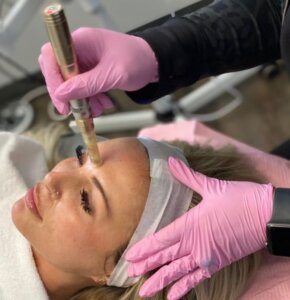Microneedling

Known as microneedling, collagen induction therapy is a skin treatment procedure that uses small needles to produce small holes in the skin. Consequently, the small open areas prompt healing mechanisms that initiate collagen, and elastin formation along with skin rejuvenation. This can be performed by dermatologists as well as experienced estheticians.
Advantages of Microneedling
Skin Rejuvenation:
Microneedling increases the skin’s texture, evenness, and elasticity. Furthermore, This results in a more youthful appearance of the skin as fine lines, wrinkles, and marks are not very visible.
Collagen Production:
The little damage produced by microneedling encourages the generation of collagen and elastin, two proteins essential for preserving the tightness as well as the flexibility of the skin. This increased collagen synthesis can lead to skin rejuvenation in the facial area.
Versatility:
Meanwhile, It’s not just the face but also any other part where micro-needling can heal scars arising from acne, stretch marks, and nonuniform skin pigment”
Minimal Invasiveness:
Microneedling needs no significant recovery time because it is not very intrusive. On the whole, it causes less harm and is better accepted than more severe treatments such as chemical exfoliations or laser therapy.
Considerations and Potential Adverse Effects

Ephemeral Redness and Edema:
Intermittent redness and edema usually resolve three days following the operation in the treated region.
Multiple Sessions Required:
Sometimes it requires multiple microneedling sessions spaced several weeks apart to obtain the best outcomes. Additionally, Depending on personal skin concerns and goals, the required number of such sessions may be different.
Necessity for Professional Proficiency:
The services of a specialist are necessary for the performance of microneedling for safety reasons as well as for increased performance. Moreover, You must choose a good expert who sanitizes appropriately and has done the work for a long.
Dermal Sensitivity:
People who have sensitive skin may have a more apparent irritation or redness post micro-needling. The medical practitioner must take note of any allergies or skin conditions before commencing the treatment.
Microblading

Microblading is an approach to semi-permanent (cosmetic solution) where the artist utilizes a tool like a needle to drive solid hair-like lines into the skin to mimic human hair; realistic, pigment-infused hair-like hyper-real strokes that transform and volumize eyebrows producing effects that last typically according to skin type up to three years.
Advantages of Microblading
Authentic-Looking Results:
Microblading by imitating hair strands creates eyebrows that are natural and thick hence enhancing the facial features and avoiding the use of eyebrow makeup daily.
Semi-Permanent Solution:
Unlike regular eyebrow makeup which needs to be applied every day, microblading is a good option for those who want an easy beauty routine since its effects may go on for up to three years if well taken care of.
Customization:
Since this process is very adjustable, people can have different looks
Confidence Booster:
Properly defined eyebrows may enhance overall face symmetry and attractiveness, giving the illusion of greater refinement and boosting self-confidence.
Considerations and Potential Adverse Effects
Initial Healing Phase:
The first healing period following microblading usually lasts one to two weeks, during which time the eyebrows may seem darker and more prominent.
Touch-Up Sessions:
Usually, the first healing period is one to two weeks after microblading, and at this time eyebrows are likely to appear somewhat darker and more pronounced. Typically, a one-off follow-up session has to be scheduled between four and six weeks following the initial procedure to maintain outstanding achievements while other touch-ups may be carried out annually or bi-annually depending on how long they last
Professional Expertise:
Picking a qualified artist with experience is critical to the successful donning of microbladed eyebrows. Moreover, To avoid mishaps as well as achieve its desired results, appropriate.
Potential Allergic Reactions:
Microblading pigments could lead to allergy in different people because of the shades used. A patch test is usually recommended before the procedure to find out if there would be any reactions at all.
Key Differences Between Micro-blading and Micro-needling:
| Feature | Micro-blading | Micro-needling |
| Definition | Semi-permanent makeup technique for eyebrows | Minimally invasive procedure to stimulate collagen production |
| Purpose | Enhance the appearance of eyebrows with hair-like strokes | Improve skin texture, tone, and firmness |
| Procedure | Uses a hand-held tool with fine needles to deposit pigment | Uses a device with tiny needles to create micro-injuries |
| Application Area | Eyebrows | Face, neck, and other body parts |
| Duration of Results | 1 to 3 years | Several months, with multiple sessions needed |
| Healing Time | 1 to 2 weeks | Few days for initial redness and swelling to subside |
| Frequency of Sessions | Initial session + touch-up after 4-6 weeks; annual touch-ups | Multiple sessions spaced weeks apart |
| Pain Level | Mild to moderate | Mild to moderate |
| Benefits | Natural-looking, fuller eyebrows; save time on makeup | Improved skin texture and firmness; reduced scars and wrinkles |
| Side Effects | Initial darkness, possible allergic reactions to pigment | Temporary redness, swelling, potential irritation |
| Professional Expertise | Requires a certified and experienced technician | Requires a trained professional |
| Cost | Moderate to high | Moderate to high |
| Downtime | Minimal | Minimal |
Read Also
Conclusion
Lastly, Microblading focuses on enhancing eyebrow appearance through precise pigment application to create hair-like strokes. Conversely, microneedling is geared towards skin rejuvenation, stimulating collagen synthesis and targeting diverse dermal issues. Also, Consulting a certified expert is vital to ascertain the most suitable procedure based on individual requirements and objectives.
